Brand success encompasses everything your marketing team does to develop and nurture your corporate communication.
It is the umbrella which covers the processes, workflows & tools you use to connect with, grow and understand your audience.
From brand storytelling to asset management, through to community interactions and performance measurement, all of it contribute to brand success.
In an era where competition for attention keeps growing fiercer every day, how you manage and cultivate your brand becomes increasingly important.
For example:
Facebook alone has 80 million small-to-medium business pages; a number that grows around 23% every year. (That means two business have joined Facebook in the time it took to read that sentence. Now it is four.)
That is just one platform and type of business. This number is, as you can imagine, far bigger across all of your channels!
The most powerful tool you have to stand out in such a crowded marketplace is a well-defined brand that resonates with your audience.
Why?
Because in context of fake news and faceless corporations, customers are looking for brands they resonate with.
They want change-makers, status-solidifiers and the feeling of, “Yeah, these guys get me.”
In this article, we are going to show you how you can achieve brand success, and give you the best practices for each area of the brand you manage.
Table of Content
Brand Success Step 1: Ensure Brand Consistency
Your brand is built on three pillars:
- Credibility: are you the real deal?
- Integrity: are you trustworthy?
- Resonance: do people like us do things like this?
Each of these pillars is constructed, over time, through consistency.
And we mean consistency in every sense of the word…
- You must consistently share content with your audience
- Your content must contain a consistent message
- Your content must consist of high-quality material
Take Shopify, for example:

They have cultivated a strong brand for creative entrepreneurs.
Each asset they use — from copywriting to images and product screenshots — sends a clear, well-defined message to their target audience:
“Entrepreneurs like us, run businesses like this”
They intertwine a message of simplicity, practicality, and purpose to provoke strong emotions.
You can see it in their Instagram posts:

You can see it in their blog post headlines:
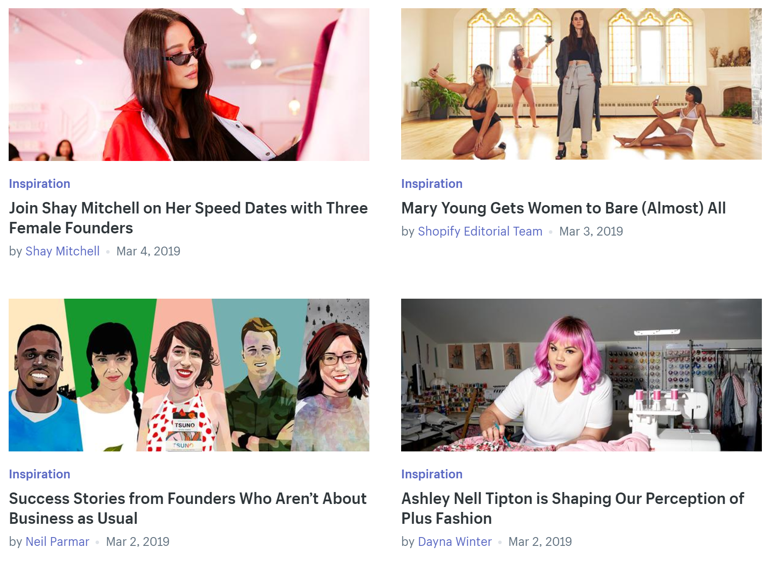
And in the video stories they tell about their customers:
These elements come together to create Shopify’s foundation of credibility, integrity, and resonance.
Why?
Because if people interact with their message enough times they start to believe the brand story.
???? The Challenges
Brand consistency can be hard to manage.
There are many different channels that need to be used and maintained, like:
- Social media
- Blogs
- YouTube
Which can make this can feel like a mammoth task.
The risk factor also goes up when you consider that you are sharing in front of a live audience, to achieve a social media ROI you are unsure of.
Or does it?
Well, not quite.
 The Best Practices
The Best Practices
Each of these problems can all be solved by building repeatable and reliable systems.
Having a well-structured system allows you to:
- Create and schedule content in advance
- Dedicate time to error-checking
- Collaborate with other divisions in your company
This is why we have incorporated two essential features into Loomly, your brand success platform:
- Social Media Calendar: so you can easily schedule content.
- Loomly Library: so you can keep all your assets in one place.
- Brand Messaging Control: so you can review and approve all updates before they are shared.
“Whether B2B or B2C, I believe passionately that good marketing essentials are the same. We all are emotional beings looking for relevance, context and connection.”
– Beth Comstock
Brand Success Step 2: Tell An Inspiring Brand Story
Chances are, your customers are not like Spock.
They do not rely on logical and rational thinking.

If they were, they would only buy the cheapest products that effectively serve a purpose, and put the rest of their money into a Roth IRA.
But that is not what they do.
Instead…
They buy expensive cars, drink artisanal coffee, queue for the latest iPhone, run in $200 shoes and write with Mont Blanc pens.
Why?
Because they rely on their emotions to make decisions.
They want to be inspired, confirm their status, join a tribe, pick a side and show the world who they think they are.
For this section, we also need to establish a little clarity on the word “inspire”.
It is easy to think it means the motivational rush you get by reading Instagram quotes, but inspiration really means to evoke a strong feeling or emotion in a person.
A brand who “inspires” in this way is Chubbies.
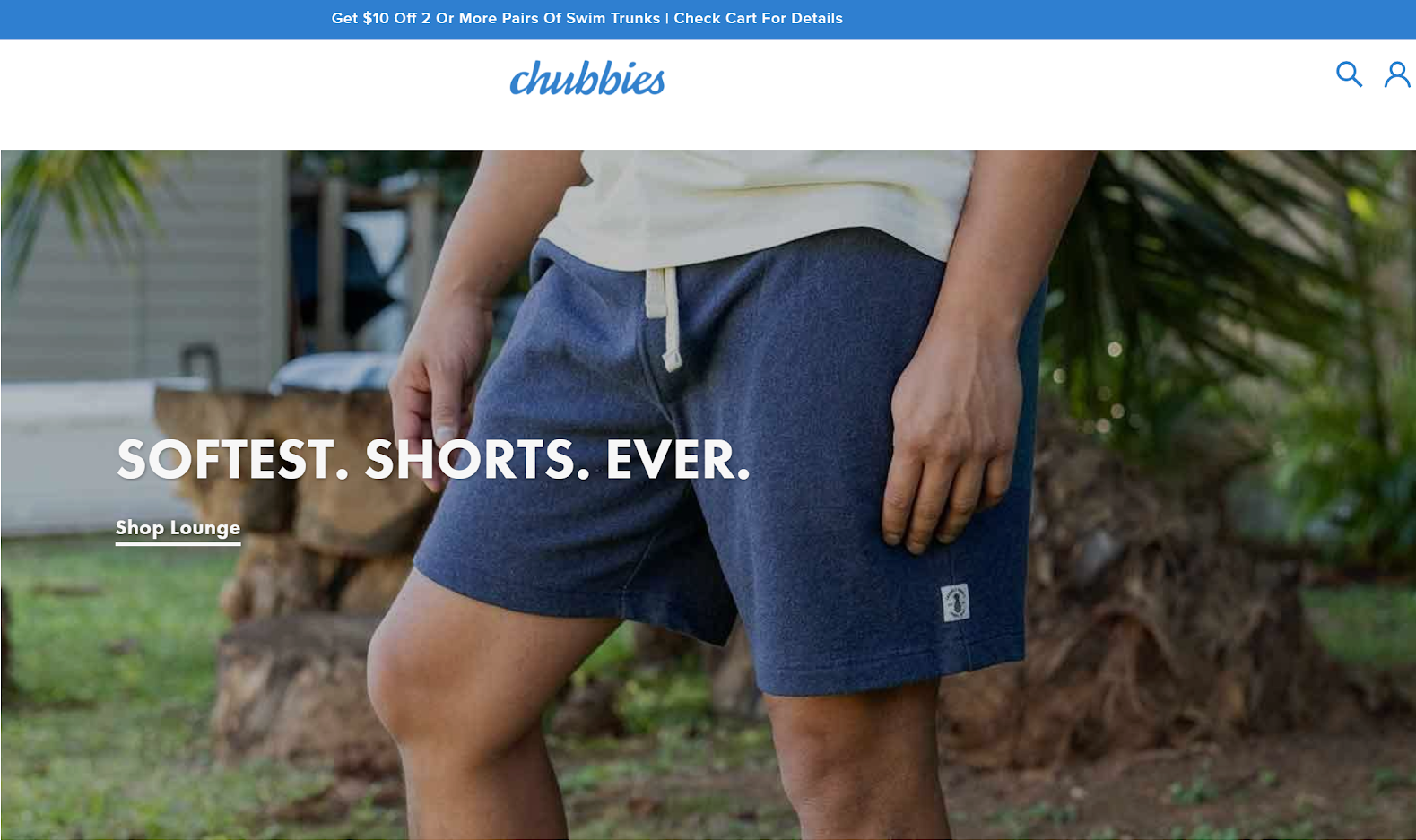
Their outrageous tongue-in-cheek branding is engineered to build a tribe around their philosophy of:
“We believe in the weekend.”
This is evident in the:
- Products they create.
- Updates they share.
- Emails they send.
To be a Chubbies Instagram follower is to consistently see entertaining updates like this:

This may seem like a comedic gimmick on the surface, but it actually shows a deeper emotional understanding of their audience.
They evoke feelings of:
- Joy
- Nostalgia
- High spirits
- Pride
- Friendship (or “bro-ness”)
- Patriotism
To inspire people to become part of their tribe.
If you believe in the Chubbies’ brand story you also believe in the list of tenants they outline on their website’s homepage:
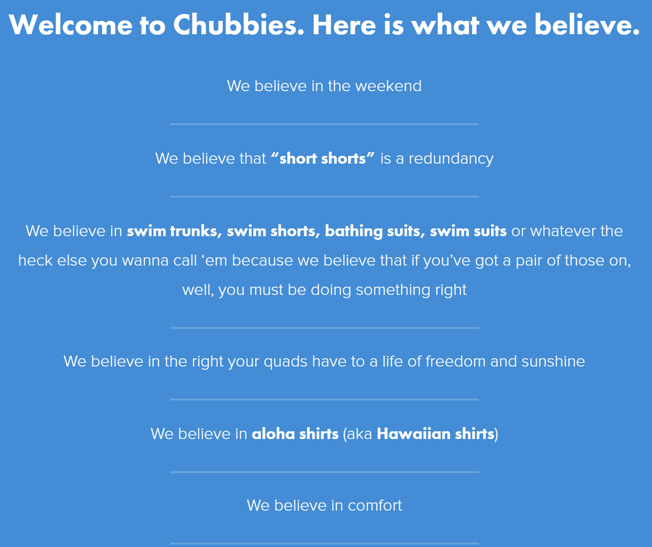
By the same token…
If you feel repelled by their branding that is also by design; they have a clear definition of who this story if for, and who it is not.
(Much like how the Mini Owners Club is only for Mini owners, Chubbies is only for people who want to be part of their tribe.)
???? The Challenges
Many brands find telling an inspiring brand story to be difficult.
Mainly because it can be hard to find the sweet spot between:
- Inspiration and promotion.
- Branding and sales.
- Engagement and conversion.
 The Best Practices
The Best Practices
But the way to achieve brand success here is to anchor your message into your audience’s worldview.
You need to connect with their culture, events, and values. Better still, you need to become associated with them.
You achieve this by creating content that is familiar to their worldview, but unique enough to tell your version of the story.
Stray too far and you will be considered alien; become too normal and you will blend into the noise.
When your updates have this anchor — and you follow the 80/20 principle of engaging to sales-based content — brand storytelling becomes a breeze.
Loomly can also help you tell even more impactful brand stories.
We suggest content ideas, so you never run out of inspiration about what to post and you can use our social media calendar to create and schedule content in advance, so you can tell a compelling story over the long term.
“The best marketing does not feel like marketing.”
— Tom Fishburne
Brand Success Step 3: Reach Your Audience Effectively
The next piece of the puzzle is ensuring the correct people are seeing your brand.
As we mentioned at the start of the article competition for attention is fierce.
There are:
- 100 million brands in the world.
- 500 million tweets published every day.
- 10,000 brand messages exposed to consumers on average every day.
That means there are a lot of people fighting for the limelight:

Thankfully, having a strong brand means it is no longer a case of who shouts the loudest. It is who is the most deliberate in what they say (and who they say it to).
To be effective in this you need to grow and nurture an engaged audience who has given you permission to send them a brand message.
Permission can be in the form of:
- Social media follows.
- Signing up to your mailing list.
- Joining your community forum.
Whichever is most relevant to your business.
The key to gaining this permission — and growing your audience — is to be specific in who you want to target.
If we were to hazard a guess…
- For Shopify: this would be physical product focused, single-person or small-team businesses, between the ages of 25 and 40.
- For Chubbies: this would be US-based males in 9-to-5 jobs, over the age of 25, who have played team sports of been part of a college fraternity.
For you, well… you need to dig deep into your audience to find that out ????
???? The Challenges
Picking a niche demographic feels counterintuitive: it is like you are reducing the number of people you want to reach.
Fewer people equals less money, right?
Well, we like to think of it a different way…
 The Best Practices
The Best Practices
Specificity allows you to craft a focused message to the right people who will tell the rest of the world about your brand.
And, with Loomly, you can literally target each message to them.
Using our Audience Restriction feature you can select all of the key defining features of your existing audience and send your updates directly to them:
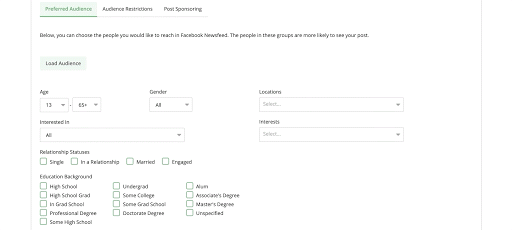
Then, you can use our Post Sponsoring feature to effectively expand the reach of your audience.
Brand Success Step 4: Manage Your Reputation
Once you have connected with the right people it is time to monitor what they say about your brand.
Nowadays, everyone is an influencer.
If they have a social media account and a handful of followers, they are able to openly share their satisfaction (or dissatisfaction) and reach an audience who values their opinion.
Chances are…
You may become interested in a product your favorite influencer posts about, but you may become convinced about a product if your close friend raves (or rants) about it.
Welcome to the age of Friends Marketing.
For instance, take a look at these people talking about Nuud Deodorant on Twitter:
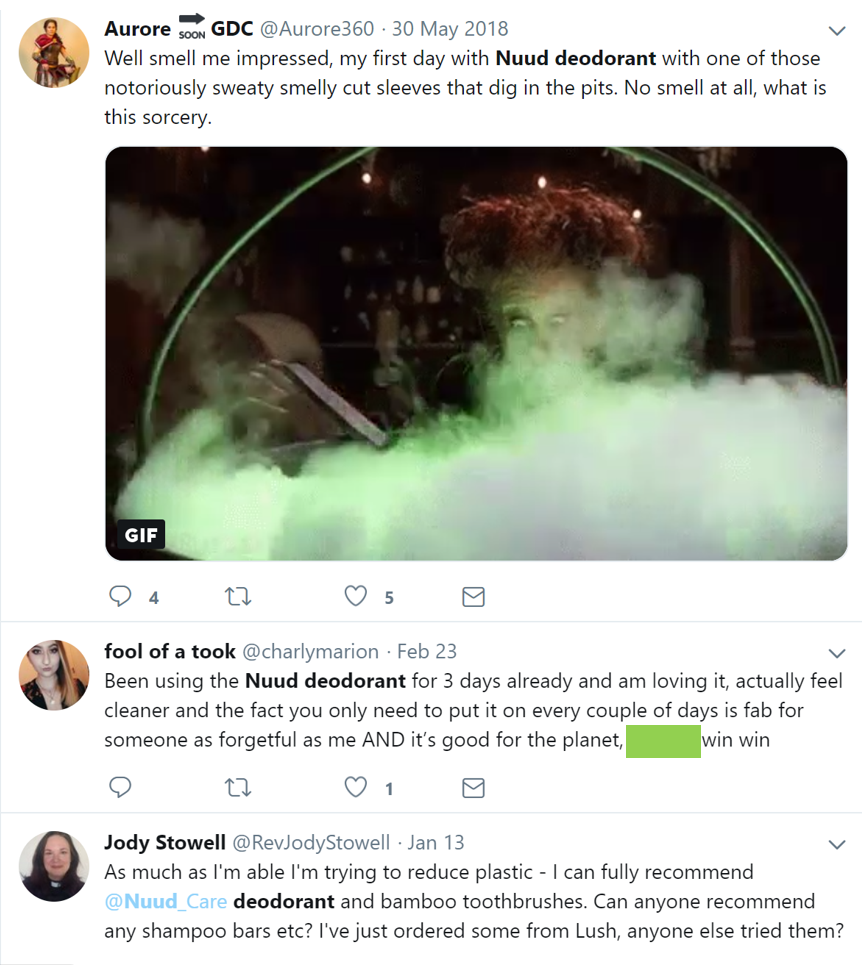
They all have a fairly small number of followers — especially compared to full-time influencers — but they can have an immeasurable impact on their audience.
Like one of the tweeters above does right here:

This influence applies to both positive and negative interactions.
Reputation management comes down to being aware of the current conversation around your brand, and intervening where necessary.
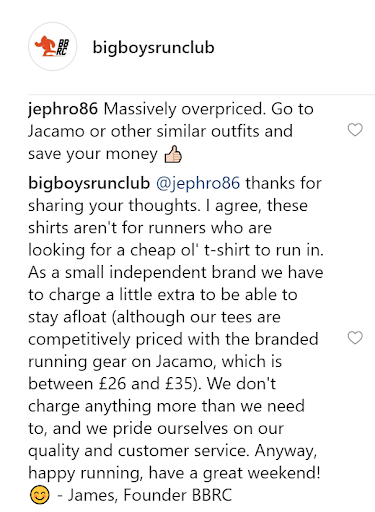
How to deal with negative social media comments is a little beyond the scope of this article.
But, know that if you do address them effectively it can improve your reputation more than the negative comment could ever damage it.
???? The Challenges
The bigger your brand is, the harder it can be to manage your reputation.
There are so many places to watch, at all hours of the day, and people expect quick responses. Even worse, many people who complain about your brand will not even tag you.
So, how can you be successful at this?
 The Best Practices
The Best Practices
Well, you need a way to collect all of your brand mentions in one easy-to-use dashboard, which also lets you respond in a timely manner.
Which is exactly what we offer with Loomly Interactions:
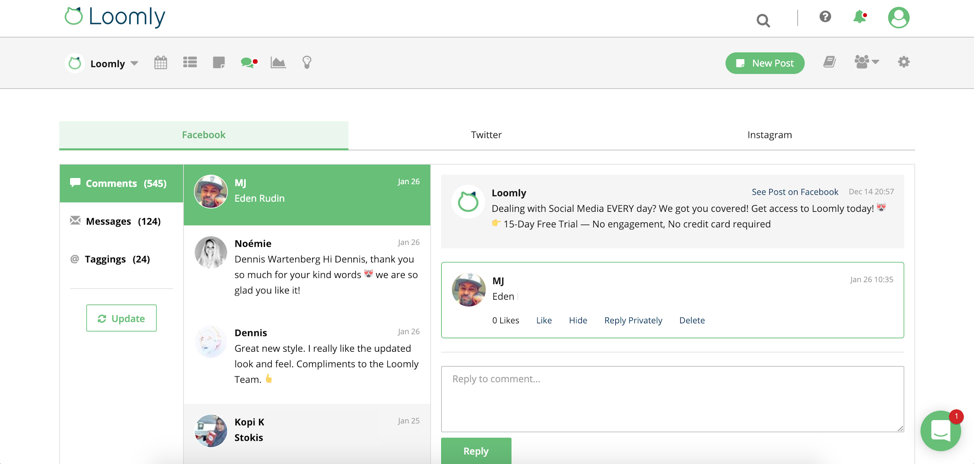
“Instead of using technology to automate processes, think about using technology to enhance human interaction.”
– Tony Zambito
Brand Success Step 5: Measure Performance
Your brand success will ultimately be decided by how you respond to data.
Being able to:
- Track performance
- Measure ROI
And use the data to make consistent data-driven adjustments is paramount to your strategy.
You need to be constantly testing, tracking and improving to ensure the longevity of your brand.
After all, we can both name a long list of viral hits that are not around anymore…
To avoid going the way of the Ice Bucket Challenge, or the Mannequin Challenge, or the “In My Feelings” Challenge, it is important to track the impact of the previous four steps on your audience using analytics data and adjust accordingly.
???? The Challenges
The marketing landscape changes really quickly.
There are:
- Expectations
- Trends
- Algorithms
- Best practices
That evolve and change over time.
Yesterday’s high-performing content could be made obsolete by tomorrow’s update. (And vise versa.)
 The Best Practices
The Best Practices
The key to success in this area is to pay close attention to your data.
Although keeping industry-happenings in the back of your mind is a good idea, your decisions should be made based on the performance metrics generated by your audience.
We have leveled-up the number of data-driven insights you can get with our Advanced Analytics suite:
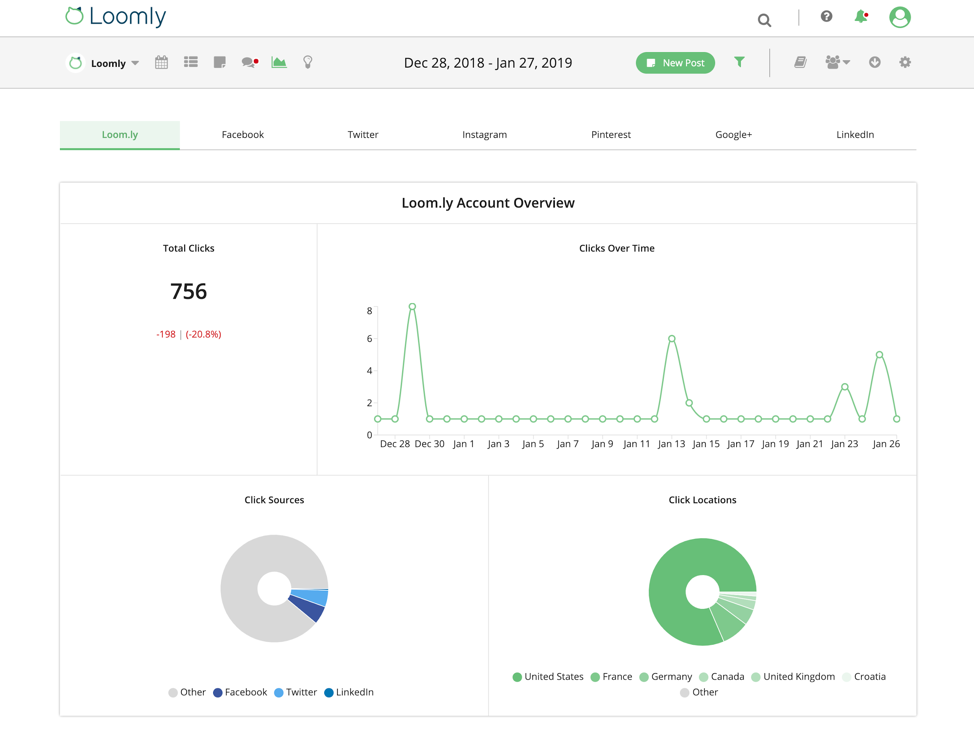
You can see data on everything from link clicks and impression, to geographic locations and engagement rates all in one easy-to-understand dashboard.
Meaning making data-driven decisions has never been easier!

Manage all your social media accounts in one place.
Craft, schedule, & auto-post content to all your social channels, then track analytics and manage interactions from a single, easy-to-use dashboard.
Wrapping This Up
However we look at it, brand success is key in today’s competitive market.
If you want to stand out and become the go-to brand in your industry, you need a cultivated brand that resonates with your target audience.
You can achieve this by following five — systematic — steps:
- Ensure brand consistency: a clear message delivered frequently.
- Tell an inspiring story: evoke emotions in your audience.
- Reach your audience effectively: highlight your key demographic, then target them.
- Manage your reputation: everyone is an influencer, so handle with care.
- Measure performance: use data to drive your decision making.
If you can follow these steps, you will be well on your way to achieving brand success.
Better still:



